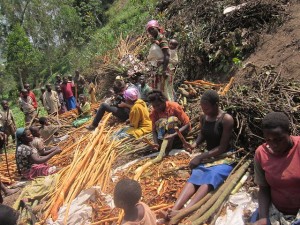
The cinchona tree, whose bark yields quinine for malaria treatment, is native to Peru. However, the Dutch and British exported seeds and trees to their colonies, including Java and Africa. In a Facebook comment on the post Malaria in the 19th Century, Noma Petroff described visiting a small quinine plantation on Idjwi Island, in the middle of Congo’s Lake Kivu. I thought her experience was worth posting, since the process she describes could have taken place in the nineteenth century–or earlier.
Getting the bark is a surprisingly peaceful process. Women come out and pound the bark off the branches (the “trees” are more like large shrubs, no more than 15 feet high), while the children play nearby. As you approach the site, you hear the sound of the children playing, while women chatter as they work. The backdrop to the whole thing is a very quiet “drumming” as the bark is beaten off the branches.
The beautiful branches remaining are actually “waste” so that the workers receive free firewood, in addition to their pay. I took one of the beautiful Quinine sticks to use for a walking stick for the next couple weeks. I wanted to bring it home with me, but my son said I would not get it through customs.
Pingback:Malaria in 19th century | Leaves of Grass
very interesting–another good post.
Pingback:Malaria in 19th century | JEAN HUETS